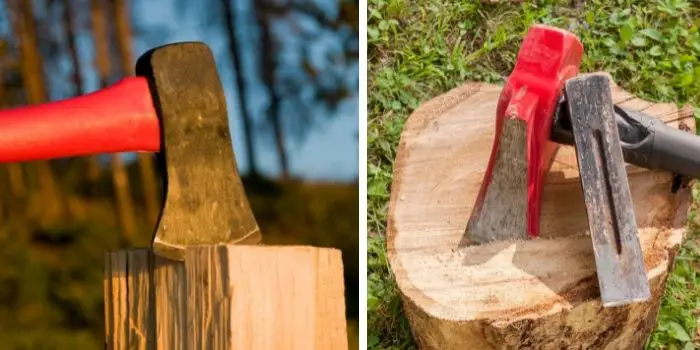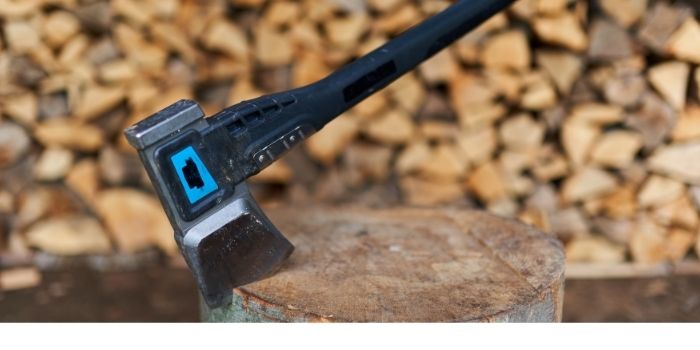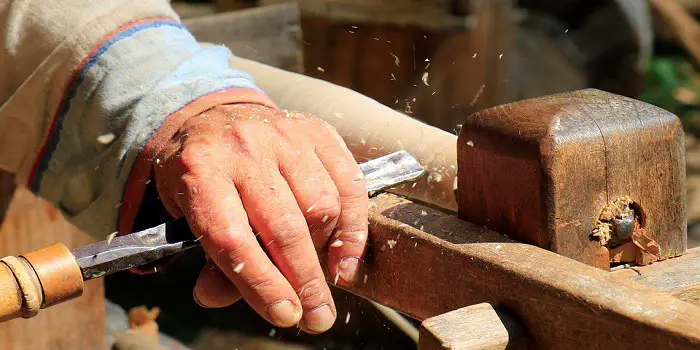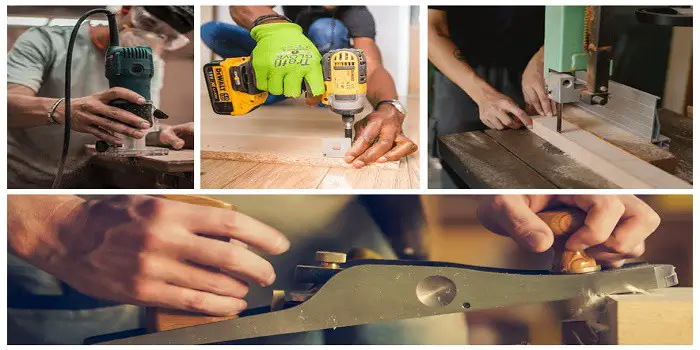
By splitting the wood for your firewood, you save time and create better, more even pieces compared to chopping.
Of course, if you have a few hundred dollars lying around, you could always get a log splitter, but that is generally beyond what most people need to split wood.
That’s the reason you will either need to use a maul or an axe as a splitting tool to make your own firewood.
So, when left between the choice of a splitting axe or a splitting maul, it pays to know what they are, their differences, and which one works better for the job.
What’s a Splitting Axe?
The splitting axe is the traditional hand tool used to split wood. It has been around for hundreds of years and is still commonly used today.
Made with a metal tapered head, a splitting axe is designed to split wood along the grain. This will break apart the fibers of the wood easier.
A typical splitting axe weighs from three to six pounds.
Plus, unlike a traditional axe which is used to chop across the grain, by splitting with the grain, you do not need to apply as much force.
What is a Splitting Maul?
Admittedly, a splitting maul can be mistaken for a splitting axe at first glance. They both have metal heads, but the splitting maul tends to be heavier at six to eight pounds.
In addition, the head of the maul is generally wider than a splitting axe and is wedge-shaped in appearance. Because of this shape, it is quite efficient at splitting wood.
One other advantage of the shape is that the head of the splitting maul does not tend to stick to the wood.
This makes using a splitting maul faster when splitting wood as it does not jam with wood like a splitting axe may tend to do.
While splitting mauls are newer compared to splitting axes, they have been engineered better, thanks to all the lessons learned with a splitting axe.
It is why many recommend a splitting maul over a splitting axe for cutting up firewood.

Splitting Axe Versus Maul: The Difference
There are four main differences between a splitting axe and a splitting maul.
The differences are the important considerations when it comes to choosing between the two.
1- The Weight
The weight of the head may be the most important difference as the extra two to four pounds on the splitting maul gives it the drive needed to split through the wood.
However, because the splitting axe is lighter, it may be more versatile and be used for other types of splitting or chopping.
But the additional weight of the splitting maul is important as it helps to split the wood along the grain.
This means that you do not have to apply as much force to get the same result. This translates to more wood split with less effort.
Of course, if you are looking for a great form of exercise, then using a splitting axe will provide a better workout compared to a splitting maul.
The balance between weight and application of force should be accounted for when deciding between the splitting axe and the splitting maul.
2- The Design
While the design of the head makes the splitting maul considerably less sticky, which means more splitting and less removal of wood splinters.
If you look at the blade of a splitting axe, it tends to be thin, sharp, and with a tapered head.
The head of a splitting maul is fatter and blunter, which makes it more capable of splitting larger pieces of wood.
It is true that the fatter head makes it more difficult to accurately split the wood, although the weight does assist in having to use less force.
But there is a steeper learning curve with the splitting maul to use it correctly. But for larger pieces of wood, it is superior compared to the splitting axe.
3- The Handle
The handle is a lesser consideration since they are both functional.
However, the splitting maul’s handle is a more recent design taking into account new understandings of splitting wood.
The splitting maul has a longer handle which means that when you swing, it is more likely to strike the wood and not wind up back at your feet.
The length of the handle is an important safety consideration.
The shorter the handle, the more likely it will miss the wood and swing toward your feet, legs, or body.
This is why the splitting axe is considered more dangerous to use. However, if you practice the proper technique, keep your feet well apart, and take your time, the risk is minimal.
4- The Cost
And finally, the cost should be considered depending on how often you are splitting wood.
Although the cost will be dictated in large part by the size, quality, and availability of each item, generally speaking, the splitting maul is more expensive compared to the splitting axe.
This is because the splitting maul is larger and thus has more material.
In fact, you should pay a little more for a splitting maul to ensure that it is of good quality. A poor-quality splitting maul represents a safety hazard when in use.

Maul or Axe for Splitting Wood: What Should I Choose?
A considerable part of your decision will be based on which one appeals to you the most.
How much work you will need to do will also be a determining factor, combined with the size of the wood that you are splitting.
Large or small wood pieces
If you are splitting large pieces of wood, then a splitting maul is superior. You can split large pieces faster, although it is a tiring effort because of the weight of the maul.
However, with the right technique, you can split large pieces effectively and at a faster pace compared to a splitting axe.
Therefore, if you are splitting large pieces of wood for the fireplace or outdoor fire, a splitting maul should be your first consideration.
However, if you are splitting smaller pieces of wood, then the splitting axe is generally better.
Chopping wood is easier than splitting ax
Another advantage of the splitting axe is that you can chop with it easier compared to a splitting maul.
That means you can chop through the width of the wood first and then split it by length using the same splitting axe.
A splitting maul is far more difficult to chop with compared to a splitting axe.
The splitting axe is also well-suited for smaller people who are not used to lifting the heavier weight of a splitting maul repeatedly.
Consider How Much Wood You Will Be Splitting Before Choosing One?
Arguably the most important consideration is the amount of wood that you are splitting.
This includes at one time and over the course of the months in which you are splitting wood for the fireplace, stove, or other uses.
If you are splitting a lot of wood, then a splitting maul should be the first consideration.
Even if you are splitting smaller pieces, the splitting maul is designed to cut between the grains and push the wood apart faster and easier.
Because of the fatter head, it is less likely that the wood will stick to either side.
This means less time to pull the wood splinters away from the head and more time splitting the wood itself.
Of course, if you are splitting a great deal of wood, such as being in a commercial operation, you should invest in a log splitter.
Do you really need a log splitter?
A typical log splitter is expensive but well worth it if you are selling wood on the market.
A log splitter is far easier to use compared to a splitting maul or splitting axe which means you can get far more work accomplished in less time and with relatively little effort.
For occasional splitting of the wood, especially smaller pieces for a wood stove, then a splitting axe is the tool of choice.
It is easier to use and just as effective in splitting smaller pieces compared to a splitting maul.
Plus, the splitting axe is more versatile, so you can also chop the wood if necessary.
It is easy enough to use that some of your family members may be able to pitch in.
FAQs
What size axe do I need to split wood?
There is no definitive answer to this as it depends on a number of factors, such as the type of wood you are splitting and your own strength and size.
However, as a general guide, most people find that a standard axe with a head weight of 4-6 pounds is suitable for most tasks.
If you are splitting particularly hardwood or you are on the larger side, then you may prefer an axe with a head weight of 6-8 pounds.
Who makes the best maul for splitting logs?
There are a number of companies that make high-quality mauls, such as Fiskars, Husqvarna, Ochsenkopf, Gransfors Bruk, and Vaughan.
However, it really depends on your personal preferences as to which one is the best.
It is worth doing some research to read reviews and compare features (like head weight, handle length, materials, and price) at sites like Amazon to find the maul that is right for you.
What is the best weight to choose for a splitting maul?
A splitting maul weighing 8 – 9 lbs is ideal since it has enough force to split most rounds yet is easy to swing.
The heftiest splitting maul I’ve ever seen is 12 pounds. The majority weigh 8 – 9 lbs. with the exception of the 4-lb splitters.
Keep in mind that a heavier maul will be able to generate more force, but it will be more difficult to swing.
So, if you are a small person or have arthritis or any other condition that limits your strength or mobility, you should opt for a lighter maul.
On the other hand, if you’re a large, strong person or if you are splitting particularly hardwood, then a heavier maul like a 12 lb may be necessary.
Ultimately, it is best to try out a few different sizes to see what works best for you.
Final Thoughts
To help make your decision simpler between splitter axe vs. maul, if you are splitting a lot of wood, especially large pieces of wood, then choose a splitting maul.
Just be prepared to receive a good workout from swinging around the heavier maul.
If splitting wood is infrequent, you only need to split a few pieces at a time, or you want an axe that is lighter and easier to handle, then the splitting axe is the right choice.
It has the size, weight, and versatility that is perfect for occasional use. This is where the cost of the item comes into play.
For occasional use, such as before the winter season begins, the splitting axe is the more economical choice. However, if you are splitting wood regularly or more often during the season, consider a splitting maul instead.

Hi, I am Mark Garner a professional carpenter, woodworker, and DIY painter. I live in the small city of Peoria, Arizona as a semi-retired woodworker. I have started this blog with a simple motive to help you with my wood experience in this sector. If you like to know more about what I love doing and how it all got started, you can check more about me here.




